Commercial NAS Operating Systems - A Comprehensive Overview of Core Features
by Ganesh T S on November 14, 2016 8:30 AM ESTNetworking Features
Network-Attached Storage units connect to the network via one or more network interfaces. High-performance units come with at least two wired Gigabit LAN ports. Some units also support Wi-Fi dongles. Multiple network interfaces in a single system can be used for a variety of purposes - ranging from link aggregation to configuration of the NAS as a switch, and, in certain cases, dedicated network interfaces for virtual machines running on the NAS itself. In this section, we will take a look at the networking features offered by various COTS NAS operating systems.
The vendors are covered here in alphabetical order. Readers interested in jumping ahead to their vendor of interest can use the links below:
Asustor
Asustor's network settings are under 'Settings' > 'Network'. There are four different aspects handled in that section - the server name and gateway settings, as well as link aggregation (creation handled by a step-by-step wizard approach) are in the General tab.
The link aggregation settings can be set to any desired mode depending on the type of switch the NAS is connected to, as well as desired performance / operation.
The LAN section specifies whether the unit is set up with a static IP or, it acts as a DHCP client. The MTU can also be altered, and the current state of the interface is also visible. Advanced settings include 802.1Q VLAN tagging, with the option to set the VLAN ID. A proxy server can also be configured for use by the NAS. Asustor's ADM supports Wi-Fi dongles connected to the USB ports of their NAS units.
Netgear
Netgear puts all the network-related settings in the 'Network' option in the top-level menu. There are two sub-options - links and routes. The links refer to the physical interfaces. Clicking on the gear icon adjoining the interface names brings up various options, including the ability to make it bond with another one.
Various teaming modes are available, and the end user can choose one depending on the switch and desired performance.
ReadyNAS also allows the network interfaces to be part of a VLAN (802.1Q support with a specific VLAN ID). It is possible to alter the MTU value in the settings for each interface. DHCP client / static IP settings are also available. New routes can be added to a specific adapter, as shown in the above gallery.
QNAP
QNAP's networking configuration sections are under 'Control Panel' > 'System Settings'. The first section is the 'Network & Virtual Switch'. The Overview sub-section shows the various physical adapters in the system along with their IP addresses and real-time transfer rates in one view. The MAC addresses are also visible in a section to right.
The Interfaces sub-section allows setting of DNS servers and port trunking configuration. In models that support usage as a direct-attached storage unit (like the TS-451A in our testbed), the Interfaces section also has a 'USB QuickAccess' entry. The way the scheme works is to have a USB network adapter chip inside the NAS. When the USB cable is connected to a PC, the PC recognizes a new LAN adapter, and the contents of the NAS are visible over that interface. Since the connection is still over a LAN as far as either OS is concerned, various access restrictions that can be places on a network share can also be placed in the USB direct-attach mode. All of these aspects are brought out in the gallery below.
The IP address supplied to the USB LAN adapter can also be configured in the same section. Upon attachment to a PC, Qfinder Pro automatically delivers a 'USB QuickAccess detected' message. Even if Qfinder Pro were to be unavailable, users can just open up the network locations and access the 192.168.0.x subnet to view the QNAP NAS and access its contents in a 'direct-attach' mode.
Yet another interesting aspect is that of the Virtual Switch. QTS can configure a set of available adaters in either 'private network mode' or 'switch mode'. In the former, the NAS can act as a DHCP server on the selected interface. In the switch mode, the unit can act as a DHCP relay with the uplink port going to the router, and the downlink ports all connected to different devices that still act as DHCP clients for the main router in the system.
QTS also has a 'Network Access' section that helps in service binding - i.e, allowing some services only on certain interfaces. The configuration matrix can be seen in the above gallery. The NAS units can also be configured with a proxy, and options are available for using a dynamic DNS service. VPN client services are available through a separate VPN Client application available under 'Control Panel' > 'Applications'. Both PPTP and OpenVPN are supported.
Synology
Synology's network configuration options are available under 'Control Panel' > 'Connectivity' > 'Network'. Various link aggregation modes are supported when bonds are created in the Network Interface subsection.
The General configuration section helps set the server name as well as the adapter to use for the default gateway. A proxy server can also be configured. Under the Network Interface section, VPN connections (PPTP or OpenVPN or L2TP/IPSec) can also be created.>/p>
Synology's DSM also supports Open vSwitch for running Docker DSM and Virtual DSM. Traffic control rules in terms of guaranteed bandwith and limitation of bandwidth are available on a port-by-port basis. IP routing tables can also be set up. Wi-Fi options are available under 'Connectivity' > 'Wireless', with the NAS capable of acting as a wireless AP, a wireless router or just a WLAN client.
One of the interesting options buried in the DHCP Server section is the ability to turn on PXE (pre-boot execution environment). The boot loader needs to be placed in the root folder of a local or remote TFTP server in the same subnet as the DHCP client.
Western Digital
Western Digital's networking options under the 'Settings' menu has already been seen in multiple sections before. In this section, we just confirm that the My Cloud OS is able to support various teaming modes for link aggregation.
Other network options include static / DHCP IP configurations an jumbo frame / MTU settings. Port forwarding settings can also be configured automatically with a uPnP router. Certain options for standard service ports are readily available, as shown in the gallery above.
ZyXEL
ZyXEL doesn't carry any x86-based NAS units. Since most ARM-based NAS units are too weak to support high-performance teaming modes, ZyXEL opts for only load balancing and fault tolerance while creating a trunk. This setting can be reached via 'Control Panel' > 'Network' > 'TCP/IP' > 'Network Interface'.
The other available network settings are the bare minimum we expect from a NAS - DHCP or static IP choices for each interface, uPnP port mapping, and support for dynamic DNS service providers.


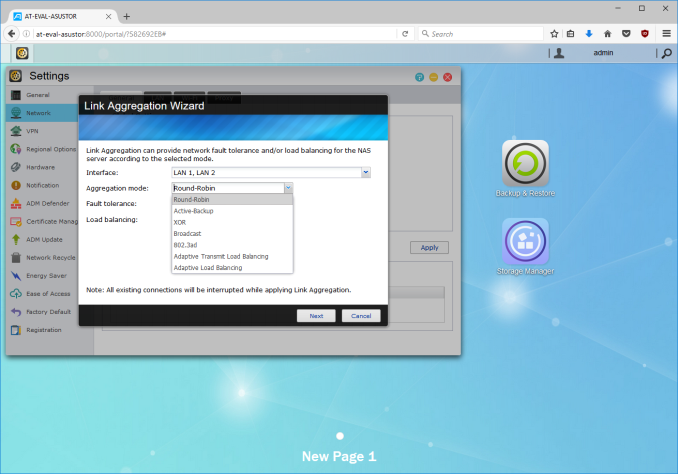






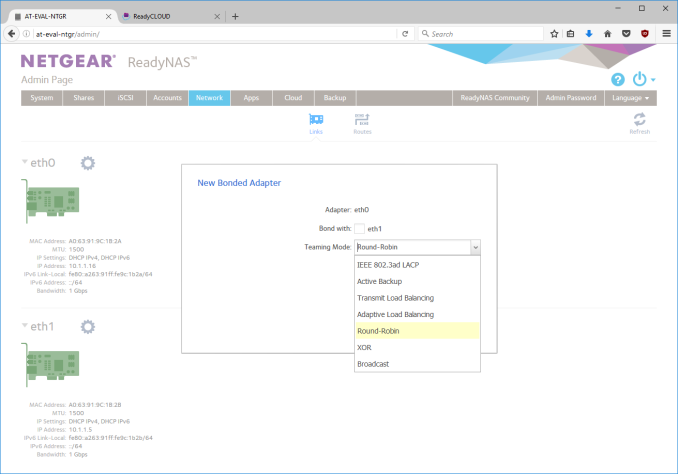






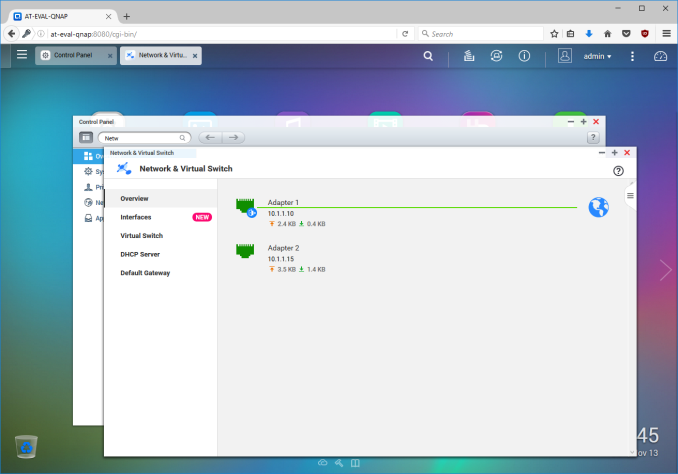






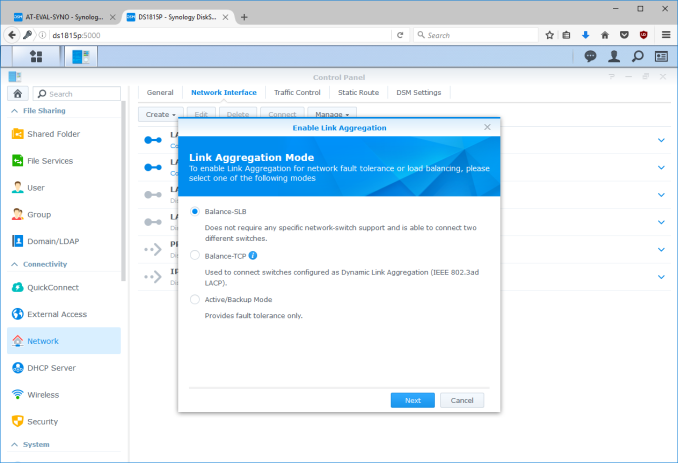













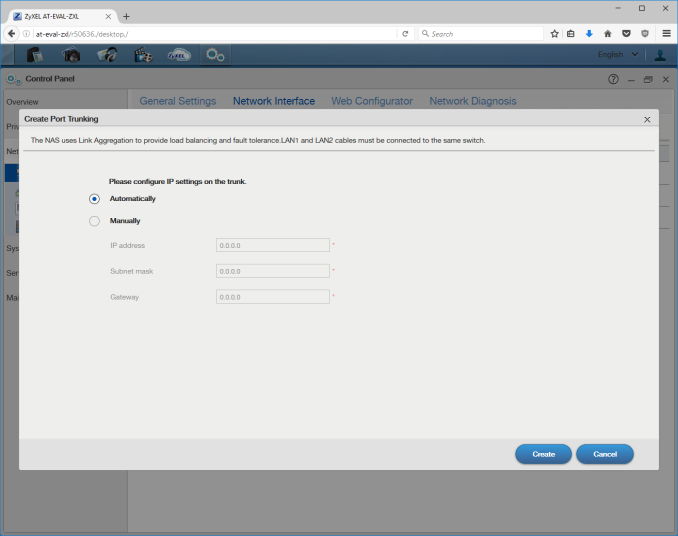














103 Comments
View All Comments
ZeDestructor - Monday, November 21, 2016 - link
Samba 4.5 (at least) supports multichannel SMB.In terms of performance, the last performance boost Samba doesn't have that Windows SMB has is RDMA, and that's being worked on.
ZeDestructor - Monday, November 21, 2016 - link
Samba 4.5+ provides non-experimental multichannel SMBOreoCookie - Monday, November 14, 2016 - link
It's about convenience and security, not about upfront cost for the device. Paying for my Synology will probably give me ~5 years of OS and package updates, and several nice services that just work by ticking a checkbox. I'm managing Linux and FreeBSD boxes at work, among other things, and I don't want to do that with my home NAS.Beany2013 - Wednesday, November 30, 2016 - link
....and that is exactly why I have a Syno. I've got two dozen Linux servers I look after at work all day (and out of hours). I don't want to be fucking about with SMB config files at home. I just want to listen to music, watch videos and run the odd VM off an iSCSI LUN without all the tedious messing about.jabber - Tuesday, November 15, 2016 - link
And once you've finished messing around with all of that it will have cost you $1000 in just time and effort. Then it fails a month later and you have to start again. Hence why I buy off the shelf NAS units for small business customers. 99% of them just want a place for file sharing and backups.beginner99 - Tuesday, November 15, 2016 - link
I disagree. You will then also need a Windows license and almost certainly a SATA/RAID controller card. Plus if the harware is old it might not support transcoding or encryption. You can get a 4-bay NAS that has all of this for less than $300.You don't only bay for the hardware. You also pay for the software which makes it easy to setup and use and for the compact enclosure. Any desktop/tower with 4 bays is way, way bigger than these NAS units.
I say this because I'm looking into buying one. right Now I just use my main PC as "NAS" (shared folders).
NeatOman - Tuesday, November 15, 2016 - link
FYI, you can ussually pick up a "off lease refurbished" PC for $60-$100 with 90 day warranty from Microcenter. ~3GHz dual core and 4GB of ram etc.I've always known Windows soft RAID is kind of a joke, and i remember giving it a try many years ago just to see the BAD drive being took as the "good" drive and drop the accrual good drive causing as many problems as you can think. Which brings me to what I've been testing, a RAID10 setup with old 2.5" 500GB drives that are known bad drives using Windows 8/10 ReFS. I'm very surprised, VERY. I Copy a 7zip file (100GB) a few times every few weeks and test it. I've replaced two drives in the 4 drive setup in the 6 months i've been running it.
The RAID10 is used for 24/7 torrenting on my main rig with no ECC, so there is consistent read/writes going to it.
SnowleopardPC - Saturday, November 26, 2016 - link
IDK, Sometimes you can find a $100 special on CL..... I recently purchased 3 Dell PowerEdge 2650 rack servers with 16gb ram each and 2TB in 15k SAS drives from a business that was upgrading and selling off their old servers. While they are not the latest and greatest, They work great with the PERC hardware raid controllers in them. Need more space, drives keep getting cheaper every day....... Just don't ask me about the electric bill running 3 rack servers in the house.., :-)SnowleopardPC - Saturday, November 26, 2016 - link
Oh..... and I paid $75 for all 3. That was a deal.darwinosx - Monday, April 3, 2017 - link
If you read this article you would be aware of the many advantages of a NAS over a PC.